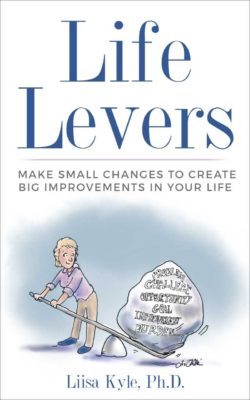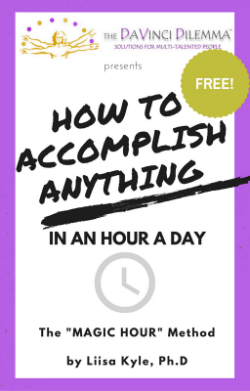
By photo taken by flickr user *Micky* (flickr) [CC BY-SA 2.0 (https://creativecommons.org/licenses/by-sa/2.0)], via Wikimedia Commons
It doesn’t have to be like that.
Downtime can be expected or unexpected. It can occur for brief or prolonged periods of time. It might be self-imposed or caused by things out of our control. Whatever the kind of downtime, let’s consider how better to use it.
Expected vs Unexpected Downtime
If you know you’re going to encounter some downtime, it’s easy enough to make the most of it. Let’s say you have to go to the D.M.V. or the doctor’s office or somewhere else where you *know* you’re going to have to wait. You have a choice about how to spend that time. You can do “‘Something Productive” — make some phone calls or read or catch up on your email or attend to small, portable tasks on your “To Do” list. You can do “Something Fun” — like people watching or doodling or playing games on your iThingy. You can do “Something Relaxing” — you can sit there, doing absolutely nothing. Or daydreaming. Or meditating. Or jotting down things for which you’re grateful.
How to choose what to do? Do what makes sense for you at that moment. Do whatever you’d really love to do. If you’re tired, relax. If you’re bored or stressed, play. If you’re feeling a hankering to get something done, do so.
The trick is to be proactive about your choice. It’s fine to do ‘nothing’ — as long as that is your intention. Otherwise it won’t feel good.
The other trick is to make your decision as quickly as possible. It’s not helpful to spend those five or ten minutes in the waiting room agonizing about what you should be doing. Choose something — anything — and do it.
If you don’t already, make a new practice of preparing for possible down time. When you think you might have a lull, give some thought to the best use of that time. (Oh, I have to drop by the bank — let me grab a book to read in case there’s a queue.)
What if you find yourself with time to kill when you don’t expect it? Prepare for it now.
Activity: Right now, answer the following:
If I have ten or so spare minutes, what would be productive? (List at least five things).
If I have ten or so spare minutes, what would be fun? (List at least five things).
If I have ten or so spare minutes, what would be relaxing? (List at least five things).
Now capture your answers on an index card or an iThingy file so you always have it handy. The next time you find yourself with unexpected downtime, refer to your lists, take no more than five seconds to select an activity and do it.
Self-Imposed or Out of Your Control
It’s up to you to manage your downtime, however it arises. If you are planning to take off a few minutes or an evening or a month, you can give thought to how best to use it, based on what’s going on with you. It’s helpful to consider not only what you’d like to do, but why.
Be strategic about the downtime you choose to take. Reward yourself for good work with guilt-free play. Use down time to get more balance in your life — to take care of your health or your family.
If you’re burned out, use down time to refresh and recharge.
If you’re stressed, use down time to relax. To soothe yourself.
When you think about the purpose of this particular down time, it’ll narrow down which activities are most helpful at this time. It’s just as important to consider how you don’t want to spend this time. If you’re fatigued, it’ s better to choose to nap for an hour than to spend the time frantically internet surfing or cleaning the kitchen or downing a pint of ice cream.
Of course, some down time is imposed by things out of your control. How to make better use of it depends, in part on the amount of downtime.
Brief vs Prolonged Downtime
The techniques above work particularly well with brief downtime. Similarly, if you foresee a prolonged period of downtime, you can brainstorm your options proactively and act accordingly. Let’s say you’re planning a holiday. Why not embrace it as a chunk of welcome, expected downtime? Make of it whatever you wish.
Ask yourself: How would I like this period of time to be? What would I like to do? (Relax. Eat tasty treats. Explore somewhere new, etc.) What can I learn? What new things can I try? Equally importantly, what would I like to avoid doing? (I choose not to fret, stress, worry. I don’t want to think about work or situation X or person Y. I’m putting all that on pause for the duration).
When you are deliberately taking time off, be sure to park any guilt, misgivings or other unhelpful thoughts that will disrupt your downtime. What good is a day off if your mind is in the office? What good is a week away when you spend it dreading whatever it is that’ll be awaiting you when you return?
It’s a little different when you find yourself in the midst of unexpected, prolonged downtime. Sometimes things happen and find ourselves amid an unproductive period.
The first step is to recognize that that is what’s going on. Maybe your computer implodes or the power goes out or you break your arm. (Um, guess I’m done for the next while). Perhaps you’re affected by some personal situation or professional source or stress that is hampering your productivity. (The Jones account is in peril. I must pause progress on what I thought was my top priority). It might be that you find yourself in a strange new situation — it may take awhile to get back up to speed. If you lose your job or a loved one, for example, you need to allow yourself some time to react and recover.
Above all else, when you do recognize that you’re being unproductive, avoid beating yourself up about it. “Arrgh! I’ve don’t nothing for two days! I’m a lazy good-for-nothing” is not helpful. Instead, pat yourself on the back for noticing. Better to have lost two days than three or more. Now that you recognize what’s going on, you can move forward.
The second step is to accept the situation. (For whatever reason, I’m experiencing prolonged downtime. Nothing I can do about it so I might as well make the best of it). For example, last week, I found myself managing two large renovation projects. I had one crew jackhammering behind my building and another crew wielding nail guns right outside my window. It was noisy. It was stressful. We were running over budget, over time, and in bad weather. There was nothing I could do to change any of that. I had to accept the situation — and to accept that these days were destined to be less productive than I’d like.
The third step is to make the best of it. Right now, having recognized this period of downtime, what makes sense for me? What can I reasonably accomplish? What would be better to postpone? Is this an opportunity to do something else? (Okay, I’ve broken my arm. I can’t type. I’ve been meaning to try dictation software but never had time to get it set up. Seems like now would be a good opportunity to do so).
Prolonged downtime — expected or not — is a wonderful opportunity to learn something new. To try new activities ‘just for fun’, without expectation.
It’s also a way to adjust the balance in your life. If you’ve been working too hard, it’s a chance for R & R — and to reconnect with folks you care about. If you’ve been neglecting your health, you can give it some attention.
The point is that, once you realize you’re going to have some downtime — or if you find yourself in the middle of it — it’s better to make a choice about how you want to use the time at hand. Be strategic. Be kind to yourself. Use down time as a way of giving yourself what you need at the time.
***
 For more ideas on how to be productive, check out my book YOU CAN GET IT DONE: Choose What to do, Plan, Start, Stay on Track, Overcome Obstacles, and Finish
For more ideas on how to be productive, check out my book YOU CAN GET IT DONE: Choose What to do, Plan, Start, Stay on Track, Overcome Obstacles, and Finish
Available here in hardcover, paperback, and eBook formats: http://bit.ly/YouCanGetItDone
***
Want to re-publish this article? Go for it – just include the author’s name, a link to this original post and the following text blurb:
Are you struggling with too many talents, skills, ideas? You may have The DaVinci Dilemma™! Find tools, fun quizzes, coaching, inspiration and solutions for multi-talented people at http://www.davincidilemma.com/ .



